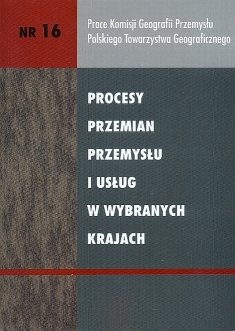Transformation and global expansion of the Brazilian aviation industry at the turn of the 21st century on the example of Embraer
DOI:
https://doi.org/10.24917/20801653.16.12Keywords:
przemysł lotniczy, Brazylia, EMBRAERAbstract
The aim of the study is to analyse the process of historical growth, transformation and global expansion of the largest Brazilian aircraft industry enterprise - Embraer (Empresa Brasileira de Aeronautica). The company history can be divided into three main stages. The first one lasted from 1969 until the second half of the 1980s. In that stage, the company developed production supported mainly by the government or on license technology. The second stage lasted from the end of the 1980s to the mid-1990s. This was the stage of the crisis and transformation of the company, which ended up with its privatization and recovery. The last stage, lasting from 1996 to 2009, was characterized by dynamic growth of production and sales. The new family of regional jets (ERJ-145 and Embraer 170/190) turned out to be a great selling success which has enabled the company to maintain its position as a global leader in regional jets, which vies with the Canadian Bombardier for the third place in the world ranking of aircraft manufacturers.Downloads
Metrics
References
Cassiolato J.E., Bernardes R., Lastres H., 2003, Transfer of Technology for Successful Integration into the Global Economy, A case study of Embraer in Brazil, United Nations, UNCTAD, New York–Geneva.
Embraer Annual Report 1999, 2000, Embraer, São Jose dos Campos, http://www.embraer.com.br/relatorios_anuais/relatorio_1999/ing/index.htm.
Embraer Annual Report 2001, 2002, Embraer, São Jose dos Campos, http://www.embraer.com.br/relatorios_anuais/relatorio_2001/eng/index.htm.
Embraer Annual Report 2007, 2008, Embraer, São Jose dos Campos, http://www.embraer.com.br/relatorios_anuais/relatorio_2007/english/.
Embraer Annual Report 2008, 2009, Embraer, São Jose dos Campos, http://www.embraer.com.br/relatorios_anuais/relatorio_2008/english/flash.asp.
Embraer in Numbers, 2009, Embraer, São Jose dos Campos, http://www.embraer.com.br/english/content/imprensa/embraer_numeros.asp.
Embraer timeline, 2009, Embraer, São Jose dos Campos, http://www.embraer.com.br/timeline/english/.
Frischtak C.R., 1992, Learning, Technical Progress and Competitiveness in the Commuter Aircraft Industry: An Analysis of Embraer, Industry Series Paper, no. 58, Industry Development Division, World Bank, New York.
Goldstein A., 2002, EMBRAER: From national champion to global player, CEPAL Review, no. 77, s. 97–115.
Goldstein A., McGuire M.S., 2004, The Political Economy of Strategic Trade Policy and the BrazilCanada Export Subsidies Saga, World Economy, vol. 27/4, s. 541–566.
Goldstein A., 2006, The Political Economy of Industrial Policy in China: The Case of Aircraft Manufacturing, Journal of Chinese Economic and Business Studies, vol. 4, no 3, s. 259–273.
Kanatsu T., 2006, Choice of national strategy and industrial organization comparing airframe production between Brazil and Japan, International Journal of Asia Pacific Studies, vol. 2, s. 1–27.
Mitchell R., 2005, The little aircraft company that could, Fortune, 11 July, s. 64–69.
Ramamurti R., 1985, High technology exports by state enterprises in LCCs: The Brazilian aircraft industry, Developing Economies, vol. 23/3, s. 254–280.
Mattos B.S., 2006, A Brief History of Brazilian Aeronautics, Proceedings of the 11-th Brazilian Congress of Thermal Sciences and Engineering – ENCIT, Curitiba.
Downloads
Published
How to Cite
Issue
Section
License
Articles are published under the terms of the Creative Commons License (CC BY-ND 4.0; Attribution– NoDerivs).

